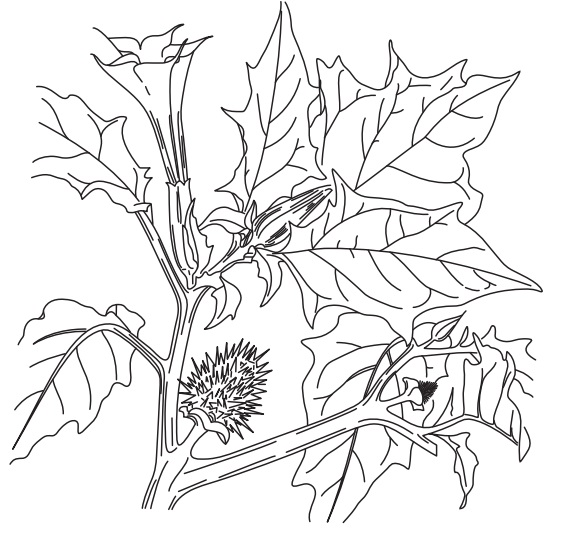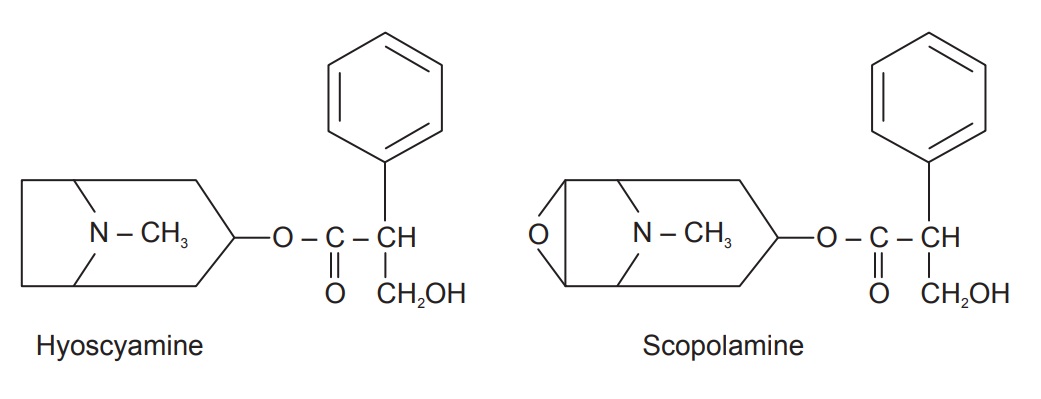Stramonium
| Home | | Pharmacognosy |Chapter: Pharmacognosy and Phytochemistry : Drugs Containing Alkaloids
Stramonium consists of dried leaves and flowering tops of Datura stramonium Linn, or its variety D. tatula Linn., belonging to family Solanaceae.
STRAMONIUM
Synonyms
Thorn apple leaves; Jimson or Jamestown weed; Dhatura;
Stinkweed; Devil’s apple; Apple of Peru; Folia stramonii.
Biological Source
Stramonium consists of dried leaves and flowering tops of Datura stramonium Linn, or its variety D. tatula Linn., belonging to family
Solanaceae.
The drug is required to contain not less than 0.25% of
alkaloids calculated as hyoscyamine. Prepared Stramonium is the finely powdered
drug adjusted to an alkaloid content of 0.23–0.27%.
Geographical Source
Stramonium is found widely in European, Asian, and American
countries and in South Africa. The plant grows commonly in waste places
throughout India from Kashmir to Malabar. It is cultivated in Germany, France,
Hungary and South America.
Cultivation and Collection
Datura prefers a rich calcareous soil. It can be grown from
seeds in spring in drills; the plants are later thinned to stand 3 m apart in
raws. The plant is sensitive to frost and sheltered situations are preferred
for cultivation. Entire plants are cut down when the fruits are mature.
Nitrogen manuring, which favours the growth of plants, also flavours alkaloid
formation. At the end of August leaves and flowering tops are collected and
dried at 45–50°C.
Characteristics
D. stramonium is a bushy annual herb, 1.5 m high,
having whitish roots and numerous
rootlets. The dried leaves are greyish-green in colour, thin, brittle, twisted,
broken, whole leaves 8–25 cm long and 7–15 cm wide; shortly petiolate, ovate or
triangular-ovate in shape, acuminate at the apex and have a sinuate-dentate
margin. The margin possesses teeth dividing the sinuses; the lateral veins run
into the marginal teeth.
Microscopy
A transverse section of a leaf has a bifacial structure;
covered with a smooth cuticle and possess both stomata and hairs.
Micro-sphenoidal and prismatic cluster crystals of calcium oxalate are abundant
in the mesophyll. The stomata are of the anisocytic and anomocytic types. The
epidermal cells have wavy walls. The uni-seriate clothing hairs are three- to
five-celled, slightly curved and have thin, warty walls. Small glandular hairs
with a one- or two-celled pedicel and an oval head of two to seven cells are
also present. The midrib has a bicollateral structure and characteristic
subepidermal masses of collenchyma on both surfaces. The xylem is a curved arc.
Sclerenchyma is absent.

Chemical Constituents
Stramonium contains 0.2–0.6% alkaloids. The main alka-loids
are hyoscyamine and hyoscine (scopolamine). It also contains protein albumin
and atropine.
Atropine is formed from hyoscyamine by racemization. At the
time of collection these alkaloids are usually present in the proportion of
about two parts of hyoscyamine to one part of hyoscine, but in young plants
hyoscine is the pre-dominant alkaloid. The larger stems contain small amount of
alkaloid and the official drug should contain not more than 3% stem with a
diameter exceeding 5 mm.
Ditigloyl esters of 3,6-dihydroxytropane and 3,
6,7-trihydroxytropane have also been isolated from the roots in addition to
hyoscine, hyoscyamine, tropine and pseudo-tropine,
D.stramonium also contains 6-hydroxyhyoscyamine, skimmianine, meteloidine, acetyl
derivatives of caffeic, p-coumaric and ferulic acids, β-sitosterol, stigmasterol, campesterol, with anolide I,
steroidal glycosides daturataturins A and B; flavonoids chrysins, quercetin
and kaempferol and their esters

Uses
It is a narcotic, antispasmodic and anodyne drug and used to
relieve the spasm of the bronchioles in asthma. The leaves are ingredient of
Pulvis stramonii compositus and other powders used for the relief of asthma.
The leaves may be made into cigarettes or smoked in a pipe to relieve asthma.
They are also used in the treatment of parkinsonism, boils, sores and fish
bites. The flower juice is used to treat earache.
The fruit juice is applied to the scalp for curing dan-druff
and falling hair. Stramonium ointment, containing lanolin, yellow wax and
petroleum, is employed to cure haemorrhoids.
Marketed Products
It is one of the ingredients of the preparation known as
Maharasayan vati (Mahaved healthcare).
